The content of the article
Cacti bought in a store are immediately transplanted into another pot. The substrate that professionals use to grow the plant is devoid of nutrients. You will have to regularly fertilize, otherwise the prickly succulent will wither and never please the owner with bright pink or delicate white buds.
How to choose a pot
Cacti have been living without water for months. They accumulate liquid in juicy pulp and carefully consume it. More green "hedgehogs" are afraid of abundant watering and too moist soil in which the fungus appears. So that the cactus has time to spend water and does not suffer from mold, you need to choose the right pot.
Clay containers are preferred. The material absorbs moisture and passes air, providing oxygen to the cactus root system. There should be drainage holes in the bottom of the pot through which excess fluid can flow. You can not buy glazed clay. Plastic pots are also suitable.
How to determine the size of the tank? The height depends on the type of root system. Fiber-like cacti will love a wide but low flowerpot. Green hedgehogs with a massive and long rhizome are more convenient to develop in tall pots, similar to beer glasses.
The diameter of the new house should be 3-5 cm larger than the old one. There is enough space for the cactus to feel comfortable and manage to absorb water.
The pot is washed with an antibacterial agent. Clay varieties are poured with boiling water, then dried and filled with a drainage layer. Pour the prepared soil into the container and transplant the cactus.
What basis to choose
In flower shops, special mixtures for growing cacti are presented. The land for succulents is nutritious, but heavy, so it is mixed with coarse-grained river sand and fine gravel.
In order not to buy soil, it is prepared independently. The composition of the substrate for cacti includes:
- leaf or coniferous humus - 2 parts;
- turf land taken from a garden or vegetable garden - 1 part;
- crushed coal or wood ash - 1 part;
- small stones with a diameter of 1 to 5 mm - 1 part.
Too lazy to sort out rubble in search of suitable specimens? The component is replaced by coarse river sand.
Sifting sod land is not necessary. Cacti will like needles, non-remnants of leaves and small twigs. The more heterogeneous the substrate, the lighter and more airy it is.
The soil is combined with humus, and then calcined in an oven or steamed in a slow cooker. The land is disinfected so that the root system of the succulent does not destroy the mold or colony of insect pests.
Pebbles are added to the sterile soil, which are pre-washed and poured with boiling water, and wood ash. Tiny star cacti like crushed coal. The substrate is insisted for several days so that beneficial bacteria appear in the calcined earth, and then fall asleep in the pot.
Important: You cannot add land from the beds to the base if they have recently been fertilized with cow dung or bird droppings.
At the bottom of a clay or plastic pot, fine gravel, broken brick or perlite, and grated foam are laid. The material draws excess water from the soil, protecting the cactus root system from fungus. The thickness of the drainage layer varies from 1 to 4-6 cm, depending on the height of the tank.
Do not tamp the earth in the pot. If she eventually settles, exposing the root of the plant, just add a little new soil.
Removing Succulents from an Old Tank
Touching green hedgehogs with your bare hands is painful and dangerous, because small needles can get stuck under the skin, which will cause a purulent abscess. It is recommended to wear tight gloves made of leather or fabric with rubber inserts. Other gardeners use thick foam sponges that gently prick the plant, and old newspapers folded 6-8 times. They wrap the base of the indoor flower with paper cuffs, tightly squeeze the ends and transfer it to another pot.
Small cacti are removed from the container with special forceps. The tool is sold in flower shops.
The indoor flower is no longer watered 2–4 weeks before transplantation so that all the liquid evaporates from the substrate and it becomes completely dry and crumbly. Soak the earth around the root system is not recommended, because then it increases the risk of injuring thin shoots.
How to extract succulent so as not to damage it?
- If the pot is made of clay, you need to gently tap the walls with your hand or a spatula for gardening.
- Plastic containers are gently wrinkled with your fingers to separate the earthen lump from the flowerpot.
- The pot is turned upside down.
- Hold the flower with one hand, slowly rotate the container with the other.
- The flowerpot is removed, the root system is cleaned of the substrate.
If the cactus has grown to the walls of the container, then the earthen ball is drawn around with a sharp knife. Couldn't extract the succulent? Then the flowerpot is broken or cut in half.
Before planting in a new pot, the plant is carefully inspected and preventive disinfection is carried out.
Cactus processing
Aphid or mold can settle in the rhizome of the succulent. To protect the extracted flower from pests and diseases, a special bath is prepared for it.
You will need a jar or an iron bowl and a sheet of thick cardboard, in which a small hole is cut out. Hot water is poured into the container. The temperature of the liquid varies from 50 to 55 degrees. Put the cardboard base on the cactus so that the rhizome is at the bottom and the neck remains at the top.
The plant is cleaned from an earthen coma before disinfection. If the soil has not been watered for more than 3 weeks, just shake the flower. The adhering substrate, which has managed to petrify, is soaked in warm water, and then removed.
Dip the prepared root system into a hot bath for 15–20 minutes. Remove and put on a paper towel so that liquid is succulent from the glass. Move the cactus into a plastic container or shoe box, hide from the sun for 3-4 days. A flower is placed next to a battery or other heat source.
After 3-4 days, the rhizome is examined, cutting off rotten and dried shoots, shorten the thick shoots. Thin strings do not touch, because thanks to them, a cactus pulls nutrients from the ground.
Work with a sharp knife or scissors. Ignite the blade over the fire or wipe it with alcohol to prevent infection. Fresh wounds are sprinkled with crushed activated carbon or sulfur powder.
Slices should dry and tighten. The plant is returned to the container, give rest 1-2 days.
How to plant in a pot
A thin layer of soil is poured over the drainage, water is not added. The cactus is placed on a substrate, gently spreading the roots and distributing throughout the pot. The lower part is sprinkled with earth, slightly tamping it. The root neck must be left on the surface of the earth.
Filling the pot with substrate, you need to knock on the walls so that the soil fills the voids and is evenly distributed over the tank. Pour a layer of fine expanded clay on top. For tall and large cacti, wooden props are installed. The trunk is tied to sticks with thin fabric ropes and left until the succulent has taken root in the new house.
Important: Long roots should not only be straightened, but also directed down. A plant with a curved base becomes weak and lethargic, with time it loses needles and fades.
The subtleties of care
A prickly plant is watered 2–2.5 weeks after transplantation. Cactus is hidden from the sun, but kept warm. After 14 days, when the flower adapts, and the roots dry and heal, a small portion of water with mineral fertilizer is introduced. The next day put on a lighted window.
After transplanting, did the plant stretch too far? This means that the substrate is not nutritious or the pot is too wide. It is recommended to replace the soil, adding more land, and buy a new flowerpot of a smaller diameter.
Sprout cactus
During transplantation, small growths are cut from the mother flower. Separate the workpiece with a sharp disinfected knife to protect the adult cactus from infection and rot.
Separated sprouts are placed in a plastic container. The bottom of the container should be covered with paper towels to keep it dry inside. Hide small cacti in a pantry or another room where it is cool and there is no sun. Keep the workpiece there for 3-5 days, so that the cut-off location is delayed and dried up. If you plant a wet sprout in the soil, it will not take root, it will begin to rot and disappear.
Pour a drainage layer into a small plastic glass, then a dry substrate, as for an adult cactus. Put the sprout in a small depression in the ground, but do not bury it. Periodically water or spray from a spray bottle.
When the new cactus has thin roots, it is transferred to a clay pot. Choose a miniature flowerpot, because in a large capacity a prickly flower will not survive. Expanded clay is laid at the bottom of the dishes, then the substrate is poured.
The sprout is placed in the center of the pot, the rhizome is gently straightened and corrected. They cover it with a layer of earth, clean it in a dark place. Water in 3-5 days. It takes so much time for the cactus to repair damaged thin strings and adapt to the new environment.
The grown plants are transplanted every 2–4 years. The substrate in old spiny flowers is changed after 5-7 years.
Cacti are beautiful and unpretentious, for a long time do without water and fertilizers. They love light soddy soil with expanded clay and wood ash. Transplanting prickly plants is simple: choose the right pot and substrate, transfer the flower to another container and hide from the sun. This is enough for the cactus to quickly adapt and take root, and after a few years pleased the owner with exotic buds.
Video: how to transplant a cactus

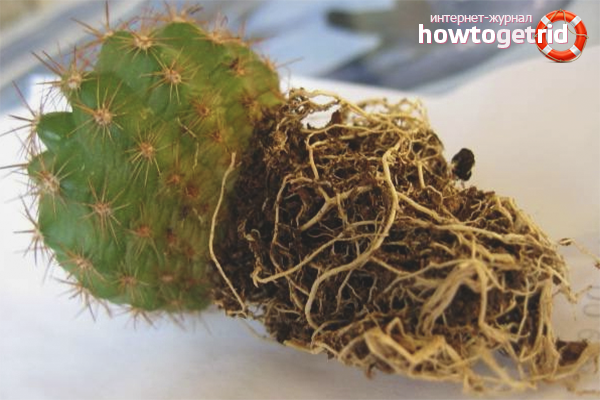
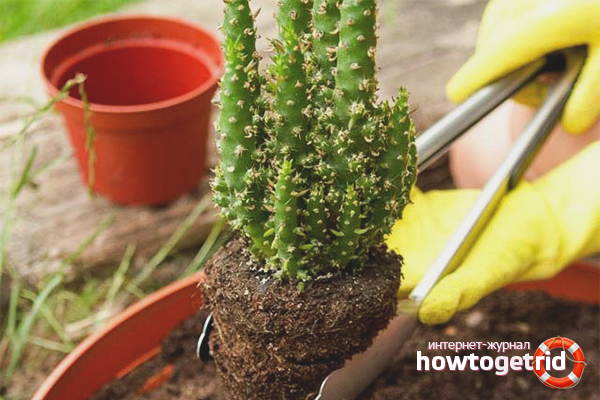
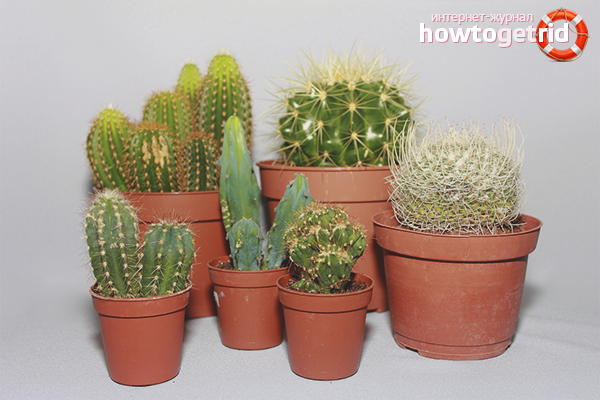



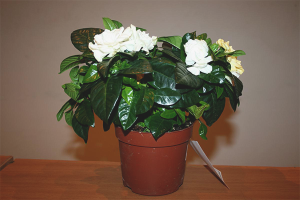
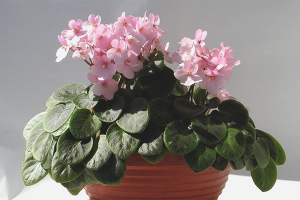



Submit